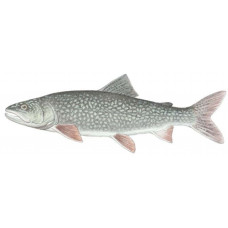Latin name
Salvelinus namaycush
Other names
Laker, mackinaw, Great Lakes trout or charr, salmon trout, landlocked salmon, gray trout, great gray trout, mountain trout, tongue, togue, namaycush or masamaycush, siscowet, fat trout, paperbelly, bank trout, bumper, humper; Cree: namekus, nemakos, nemeks; French: touladi; Inuit: iluuraq, isuuraq.
Identification
Lake trout have the same moderately elongated shape as trout and salmon. Its tail is moderately forked, larger than that of other charr. The scales are fine. It has several rows of strong teeth, which are weak, less numerous, or absent in other charr. The head is usually large, although in fast-growing stocked fish the head may be small relative to body size, and there is a fat fin. Like other charr, lake trout have white leading edges on all lower fins and light spots on a dark background. The body is usually grayish or brownish, with white or nearly white spots extending to the dorsal, adipose, and caudal fins. There are no red, black or halo spots. Coloration is highly variable. Lighter specimens often inhabit deep water in light-colored southern lakes where alewife and smelt are prey. Darker specimens, including some with reddish and orange tones, live in the less fertile, tannic northern lakes.
Distribution
The natural range of lake trout extends throughout the northern region of North America. It is found from Quebec, the Maritime Provinces and Labrador in the east, south through New York and west through the north central United States and all of Canada to British Columbia and Alaska in the west. It is widespread in Nunavut, Yukon, and the Northwest Territories, as well as the northern parts of other Canadian provinces, including the Arctic Islands. It has been introduced into northern deep lakes in other parts of the United States and has been reintroduced into parts of its native range, including the Great Lakes of North America.
Habitat
In general, and especially in the southern parts of its range or where it has been introduced south of its native range, lake trout inhabit the cool waters of large, deep lakes. In northern regions, it can be found in lakes that are usually shallow and remain cold throughout the season, and it can be found in both shallow and deep parts of lakes that have large expanses of deep water. It is also found in large deep rivers or the lower reaches of rivers, especially in the far north, although it can sometimes enter tributaries of large southern lakes to feed. It is rarely found in brackish water.
Size
The world record for any tackle is considered to be a 72-pound fish caught in 1995 in Great Bear Lake, Northwest Territories, although a 74-pound fish was also caught there in 2001. In 1961, a 102-pound lake trout was caught in Lake Athabasca, Saskatchewan. Throughout most of its range, the 20-pound lake trout is a very large specimen and is considered a trophy catch. Fish between 30 and 45 pounds are caught each season in several northern reservoirs, but most are released. The average angler's catch at most locations is between 4 and 10 pounds. The size and age of lake trout depend on habitat, food, water temperature, elevation, and genetics. Lake trout in the cold, deep, infertile waters of the north can live long lives. In the more southern parts of their range, however, they grow faster but do not live as long, and in most places they do not exceed 20 years of age.
Life history and Behavior
Lake trout typically spend their entire lives in lakes, staying in deep water and often near the bottom when water levels are cool. They are often structure-oriented, congregating near tributaries and migrating in search of food, and although they are not a schooling species like some of their foraging cousins, they can usually be found in groups, often of similarly sized individuals. Spawning occurs in late summer or early fall on clear, rocky lake bottoms. Rocky shoals or reefs are the most prominent spawning sites. Unlike other salmonids, lake trout do not nest. Spawning usually occurs at night, with peak activity occurring after dusk. Eggs hatch early the following spring. Some populations spawn every year, while others spawn every two years or less.
Food and feeding habits
The diet of lake trout depends on the age and size of the fish, habitat and available food. Foods typically include zooplankton, insect larvae, small crustaceans, mollusks, snails, leeches and various fish species, including their own species. Lake trout actively feed on other fish such as whitefish, grayling, sticklebacks, suckers and sculpin in the far north or cisco, smelt and alewives elsewhere.
Reproduction
No information
| Classification | |
| Phylum | Chordata |
| Class | Actinopterygii |
| Squad | Salmoniformes |
| Family | Salmonidae |
| Genus | Salvelinus |
| Species | S. namaycush |
| Features | |
| Conservation status | No information |
| Habitat | Pelagic |
| Life span, years | 20 |
| Maximum body weight, kg | 46 |
| Maximum length, cm | 150 |
| Sailing speed, m/s | No information |
| Threat to people | Edible |
| Way of eating | Predator |


